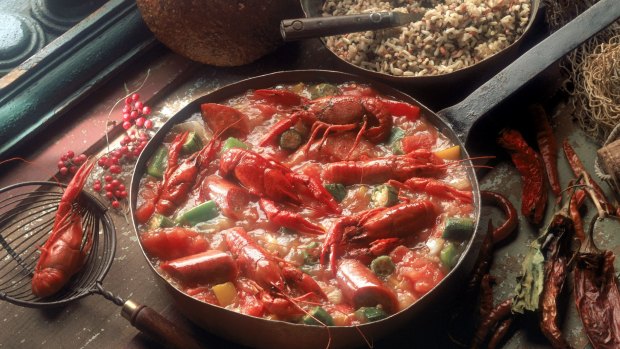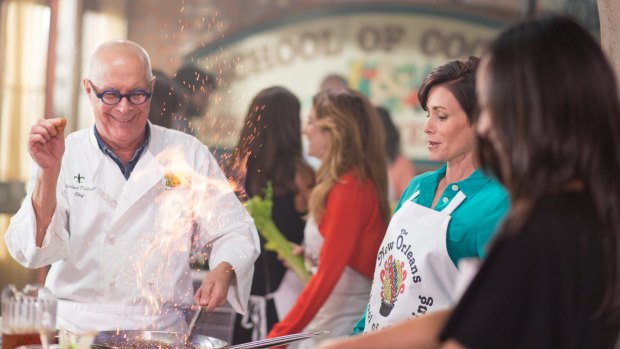This was published 4 years ago
The story of Creole, Cajun food comes alive at the New Orleans School of Cooking
By Katrina Lobley

Crayfish gumbo in New Orleans.Credit: Paul Poplis
The talk is flowing faster than the Mississippi River. New Orleans School of Cooking's chef de cuisine, Matt Guillory, is giving a potted history of Louisiana's food before we make like chefs ourselves.
We're tucked within a renovated 19th-century molasses warehouse in the city's historic French Quarter to make a very New Orleans meal – roasted sweet potato and tasso ham bisque, Cajun Benedict topped with crawfish cream sauce, and bananas Foster – but first we mix ourselves a cocktail and take in Guillory's fascinating history lesson.
Creole food, he explains, is city food while Cajun food is from the country. "It's basically French peasant food – a lot of one-pot meals, very simple fare, it's good for whatever you've got if you're cleaning out your fridge or pantry," says Guillory, who describes his city-country background as "a foot in both worlds".

A little sizzle at the New Orleans School of Cooking.Credit: D. Scott Clark
"It's a lot of brown food because if you cook it in one pot, it just turns brown. It's not very pretty, like the food of the city. Here in the city we like the plate to look nice and cook everything separate.
"But in the country, you throw it all in the pot, serve it with a lot of rice and gravy. I grew up eating rice and gravy – I didn't realise that was weird until I started meeting people from everywhere else."
Before the French founded New Orleans in 1718, "we had Native Americans first and they were already eating good," Guillory says. "They had access to all the saltwater seafood out in the Gulf – crabs, shrimp, oysters, fish – and all the wild game out in the swamp, the ducks, the bears, the alligators, the possums, and all the plants too, the bell pepper, pecan, sassafras, sunflower.
"Sassafras powder is used to thicken soup. If you get a filé gumbo, that's been thickened up with sassafras leaf. They had a lot of agriculture too. Corn, squash and beans are the three sisters – they grow together because they help one another out."
The French brought African slaves to their territory to develop the land and grow crops. They, too, influenced what was in the cooking pot, slipping in okra and black-eyed peas. They liked to cook rice, meat and vegetables in the same pan – a dish that evolved into the city's jambalaya.
"When these Africans were done cooking for the French, they had to go home and cook for their families, too," Guillory says. "They had to make do with the cast-offs, the scraps, the funny cuts and whatever they could grow out of their garden. They learned from the Native Americans some of what they do and that's where we get our soul food from."
Germans came, bringing sausage-making skills. The Spanish arrived with pigs, tomatoes, spices and peaches. The territory lobbed back to the French who sold it to the United States. A wave of Italian immigrants brought garlic. Sicilian Salvatore Lupo invented the muffuletta (a sandwich stuffed with cold cuts, cheese and olive salad) at his store, Central Grocery & Deli, which still stands today. Guillory, in case you're wondering, is a fan of Napoleon House's hot muffuletta.
My head's spinning but it's time to get cooking under the classroom chandelier. I'm paired with an American woman who loves to cook so I assign myself uncomplicated tasks like stirring whatever's in the pots and pans. We sit down to gobble our hot dishes, which fit the New Orleans culinary colour palette apart from a sprinkle of green onions on the soup and chopped parsley over the Benedict.
The most spectacular moment is yet to come. Back at the stovetops, we flip crepes, heat bananas in caramel sauce and slosh in the booze (banana liqueur and dark Caribbean rum) to make the city's classic dessert. The lights are turned down low as Guillory swings around adding fire to the bubbling concoctions. Our job is to stay back and pitch ground cinnamon at the flames, adding a little sparkly voodoo magic to the mix.
TRIP NOTES
MORE
LEARN
New Orleans School of Cooking offers demonstration classes (from $US30 a person) and hands-on classes ($US139 a person) in which you prepare and eat a three-course meal (recipes vary). According to Expedia, January is the cheapest month to fly to New Orleans. See nosoc.com, expedia.com.au
Katrina Lobley was a guest of Brand USA and Expedia.
Sign up for the Traveller Deals newsletter
Get exclusive travel deals delivered straight to your inbox. Sign up now.